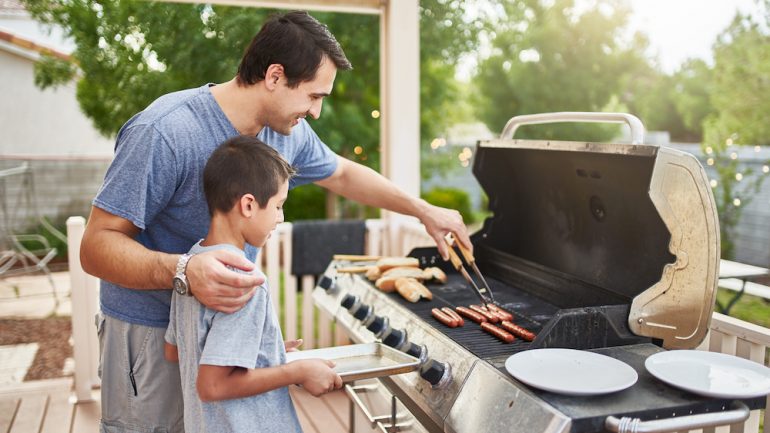We live in the golden age of outdoor grilling. Your choices for the ultimate backyard barbecue range from gas and charcoal to pellet and Kamado grills, all of which offer other great features. Let’s get grilling!
Methods of delivering heat
The major difference in grill performance lies in the fuel used.
- Gas grills burn either propane or natural gas. Most have a refillable propane gas tank. To fire up a gas grill, you push an igniter spark button. You can control the grill’s temperature by dialing the gas volume up or down and by adjusting the outside airflow through dampers.
- Charcoal grills burn briquettes. You control their heat by varying the amount of charcoal and adjusting the outside air supply with dampers. You can add wood to a charcoal fire to provide a smoky flavor to grilled foods.
- Pellet grills use wooden pellets ignited by an electrical heat source. An auger feeds the burning pellets into the firebox. The pellets combine the heat of traditional charcoal with the smoke of wood chips in one fuel. You can control the temperature of a pellet grill by turning a dial. Leave the dampers open for traditional grilling, or close them to smoke meats.
The cooking chamber
Gas grills and most charcoal grills come in rectangular steel housings with hinged lids. You can still get the vintage kettle-shaped charcoal grills with tops that lift completely free from the basin. Charcoal grills also come in barrel shapes with hinged lids, some with a smoker box attached.
In the 1970s, the grilling world was introduced to the Kamado grill, whose name comes from the Japanese word for a cooking chamber. The Big Green Egg is the most iconic of these types of cookers, but there are others on the market. The chamber is a large ceramic oval. The ceramic retains and focuses the heat in an efficient way that fans and consumer testing say is superior to other grills.
The grilling experience
Gas grills cook meats and vegetables without imparting flavor from the fuel itself. Temperatures range from 250 to 500 degrees. Some models come with a heat shield between the burners and the cooking grates to help evenly distribute and regulate heat. Gas grills avoid having hot spots in the cooking chamber, which allows for more even cooking. You can slow cook at low temperatures when needed. Some gas grills come with an electric motorized rotisserie for cooking whole poultry. Cleanup is limited to degreasing cooking grates and the inside of the lid and sides.
Charcoal grilling imparts the flavor of the briquettes, plus you have the option of using wood chips to add a smoky flavor. To grill over charcoal, you start the fire by lighting the briquettes and wait 20 minutes or so for white ash to develop on them. Temperatures of up to 800 degrees are possible, depending on the size of the charcoal used and the management of the air dampers. You can slow cook at low temperatures or sear meats at high temps. Cleanup involves removing ashes and degreasing the grates.
Kamado grills use charcoal and wood; you light them and wait to cook until the grill reaches peak heat. Kamados have the versatility to slow cook at low temps or to sear at higher ones. Kamados are excellent for baking pizzas on a baking stone.
Smart grills
The grilling world has gone high-tech, with gas grills you can operate with an app. You can start the grill, set the temperature and even use a temperature probe to display internal meat temperature, all with your phone.
Pricing
Charcoal grills can be had for as low as $100, but bigger versions with smoker chambers can be $500 or more. Gas grills start at around $100 and can run as high as several thousand dollars. Pellet grills start around $500, and Kamado grills start around $400. Either of these options can cost $1,000 or more.
Related – 5 Fail-Safe Tips to Grill Cleaning


